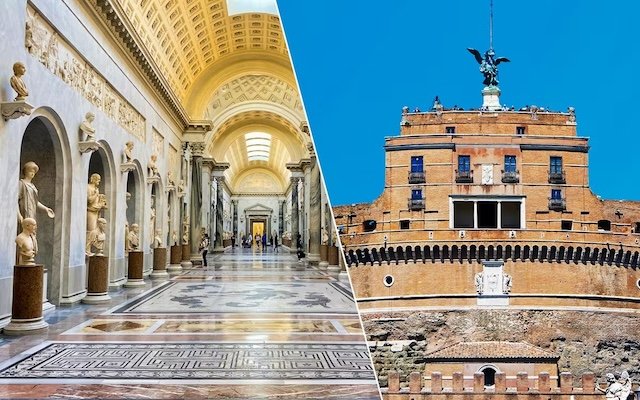Sistine Chapel: History and Facts
Sistine Chapel: History and Facts
Step into the heart of Rome and immerse yourself in the history of the Sistine Chapel. Built in the late 15th century under the patronage of Pope Sixtus IV, this iconic chapel is a masterpiece of Renaissance art. As the official papal chapel, the Sistine Chapel has served as the stage for countless papal ceremonies, conclaves, and coronations, making it a place steeped in history and significance.
Embark on a journey through time as you uncover the fascinating history of the Sistine Chapel, nestled within Vatican City. Explore its origins as a humble papal chapel and witness its transformation into a sanctuary of art and spirituality. Let’s start with some fascinating facts.
Quick Facts about the Sistine Chapel in Rome
- Address: Sistine Chapel, Viale Vaticano, 00120 Vatican City
- Original Name: Cappella Sistina, Città del Vaticano
- Capacity: 600 people
- Length: 44 meters (144 feet)
- Width: 12 meters (39 feet)
- Height: 21 meters (68 feet)
- Total Area: 520 square meters (5,597 square feet)
- Construction Started and Finished: 1477 – 1483
- Architects: Giovannino de’ Dolci, Giuliano da Sangallo, Pietro Antonio da Sangallo, Donato Bramante
- Architectural Style: Renaissance
- Building material: Bricks and tufa
- Renowned for: Michelangelo’s awe-inspiring frescoes, including the iconic ceiling with “The Creation of Adam” and “The Last Judgment” covering the altar wall.
- UNESCO World Heritage Site since: 1984
- Special Events: Papal conclave for the election of the Pope, canonizations, and beatifications.
- Number of Visitors per Year: Over 6 million
10 Fascinating Facts about the Sistine Chapel in Rome
Delve into fascinating revelations about the Sistine Chapel as we unveil these enthralling morsels:
Fade of Vibrant Colors and Intricate Details
Accumulating layers of dirt, soot, and previous varnish applications from past restoration efforts had dimmed the original vibrant colors and obscured the intricate details of the Sistine Chapel’s ceiling. Only through an extensive restoration initiative spanning from 1980 to 1994 was Michelangelo’s monumental masterpiece able to be rejuvenated to its initial brilliance.
Blue Night Sky
Before Michelangelo’s iconic frescoes adorned the ceiling, it featured a celestial-themed painting by Piero Matteo d’Amelia, an Italian artist from Umbria region. This original fresco, depicting a blue night sky dotted with shimmering stars, was created between 1481 and 1483. The name of the fresco is unknown. It was simply referred to as the “Starry Sky” or the “Celestial Ceiling”. The decision to replace d’Amelia’s fresco was not without controversy. Some art historians argue that the removal of a significant work by a respected artist was a loss to the art world.
The Chapel’s Name
The Sistine Chapel is named after Pope Sixtus IV, who commissioned its construction in 1477. The chapel was built on the foundations of the Cappella Magna, an older chapel that had become outdated and inadequate for the needs of the papal court. Sixtus IV envisioned a grander and more impressive chapel that would serve as a fitting venue for papal ceremonies and a testament to the power and prestige of the papacy.
Remarkable Acoustics
Sistine Chapel is renowned for its extraordinary acoustics. The chapel’s unique architectural features, including its high ceiling, arched shape, and smooth surfaces, contribute to creating this exceptional acoustic phenomenon. These elements work together to reflect and amplify sound waves, resulting in a rich, reverberant sound that fills the entire space.
Similar to Temple of Solomon
While there is no concrete evidence to confirm that Sixtus IV directly modeled the Sistine Chapel after the Temple of Solomon, the similarities between the two structures suggest that the Pope may have drawn inspiration from the biblical temple. The desire to connect the papacy with the sacred traditions of the Old Testament may have motivated Sixtus IV to incorporate elements of the Temple of Solomon into the design of the Sistine Chapel.
Black or White
When the College of Cardinals meets in the Sistine Chapel to elect a new pope, they use a system of smoke signals to communicate their decision to the public. Black smoke indicates that no pope has been elected, while white smoke indicates that the cardinals have reached a unanimous decision and elected a new pope. This tradition dates back to the 16th century.
The smoke signals are produced by burning different materials in the chimney of the Sistine Chapel. Black smoke is produced by burning wet straw, which has a dark, sooty smoke that is easily visible from a distance. White smoke is produced by burning dry straw, which produces a clean, white smoke that also stands out against the blue sky of Rome.
Off Limits to Women
Back in the day, women were not allowed to enter the Sistine Chapel while it was in use for religious ceremonies. This restriction was rooted in the traditional gender norms of the Catholic Church, which limited women’s participation in certain religious activities and spaces. Over time, the exclusion of women from the Sistine Chapel during religious ceremonies gradually relaxed, but it was only in the 1970s, that women were finally permitted to enter the chapel for all services and functions.
Sistine Chapel History: Chronoligical Timeline
1477
Pope Sixtus IV commissions the construction of a new papal chapel to replace the aging Cappella Magna.
1478 – 1481
The construction of the Sistine Chapel is completed, with a rectangular plan and a barrel-vaulted ceiling. The design is attributed to Giovannino de’ Dolci, Giuliano da Sangallo, and Donato Bramante.
1481 – 1482
The walls of the Sistine Chapel are decorated with frescoes depicting scenes from the Old Testament, commissioned by Pope Sixtus IV and executed by a team of renowned Renaissance artists, including Botticelli, Ghirlandaio, and Perugino.
1508 – 1512
Pope Julius II commissions Michelangelo to paint the ceiling of the Sistine Chapel. The artist’s frescoes, depicting scenes from the Creation, the Fall of Man, and the Redemption of humanity, are considered some of the greatest masterpieces of Renaissance art.
1536 – 1541
Michelangelo completes his second major work in the Sistine Chapel, the “The Last Judgment” fresco, on the west wall above the altar.
1583
The floor of the Sistine Chapel is redesigned by Giacomo della Porta, featuring an intricate marble inlay work with geometric patterns and papal coats of arms.
1700s
The Sistine Chapel undergoes a series of restorations, including cleaning and consolidation of the frescoes.
1980 – 1994
A comprehensive restoration of the Sistine Chapel is undertaken, involving the removal of centuries of accumulated dirt, soot, and varnish, revealing the vibrant colors and intricate details of Michelangelo’s frescoes.
1984
The Sistine Chapel is inscribed as a UNESCO World Heritage Site, recognizing its outstanding universal value as a masterpiece of Renaissance art and architecture.
Today
The Sistine Chapel is one of the most popular tourist attractions in the Vatican City, drawing millions of visitors each year to admire its artistic splendor and religious significance. The chapel continues to serve as the official papal chapel, hosting important papal ceremonies and events.
History of the Sistine Chapel: In-Depth Summary
Embark on a journey through the illustrious history of the Sistine Chapel with our carefully woven overview. Engage with each intricately presented segment, traversing through time to reveal the origins, transformations, and profound cultural importance of this iconic masterpiece.
Architecture of the Sistine Chapel
The Sistine Chapel, a pinnacle of Renaissance architecture, showcases the brilliance of multiple architects, including Giovannino de Dolci and contributions from Baccio Pontelli. Its Renaissance style is characterized by harmonious proportions and classical motifs. The chapel’s notable features include a rectangular plan, a barrel-vaulted ceiling, and a sanctuary with a hemispherical dome.
Beyond its architectural marvels, the Sistine Chapel houses an unparalleled collection of artistic masterpieces, primarily renowned for Michelangelo’s frescoes. The ceiling, adorned with scenes from Genesis, and “The Last Judgment” on the altar wall, exemplify the fusion of architecture and artistry, making the Sistine Chapel a transcendent testament to the symbiosis of architectural form and artistic expression.
Sistine Chapel Tickets and Tours
Immerse yourself in the historical richness of the Sistine Chapel with our carefully selected admission tickets and expertly guided tours.
Top-Seller Entry Ticket
Best-Selling Guided Tour
Top 3 Combo Tickets
>> For more options, go to our ticket page and pick from the finest selection.




















